|
| 231
|
CHAPTER 36
Paraplegics Who Walk Where
Wheelchairs Won't Enter (India)
Innovations For, By and With Spinal-Cord Injured Persons in India
Centers for rehabilitation in the United States and many other
countries encourage most spinal-cord injured persons to use wheelchairs as
their primary way of moving about. Except for a few persons with low-level
or incomplete injuries, walking is considered too difficult.
This emphasis on wheelchair riding with ease rather than
walking with difficulty reflects the current trend in rehabilitation.
The goal of maximum function is placed before normalization
- even if this means doing some things "abnormally" (differently from how
most people do them). Today, many spinal-cord injury self-help groups
strongly encourage members to "Accept yourself as a wheelchair rider
and get on with your life." Individuals are gently discouraged from
putting a lot of hope or energy into "learning to walk again."
Instead, they are urged to "join in the fight for accessibility
and social acceptance of wheelchair riders."
I was, therefore, surprised by the approach of the rehabilitation
center linked with the Christian Medical College in Vellore,
India, which I visited in 1995 during a UN workshop on "Indigenous
Assistive Devices for Disabled Persons." At the center, many
paraplegic persons were being vigorously trained to walk with leg braces
and elbow crutches.
Started in 1934 by a visionary woman doctor who was paralyzed in a car
accident, the Vellore Center is recognized as the country's best, most
comprehensive spinal-cord injury program. I was impressed, not only by the
quality of services and innovativeness of activities, but by its human
warmth and convivial spirit. The center's outstanding staff made a point
of including disabled persons in the problem-solving process: as friends,
co-workers, and equals.
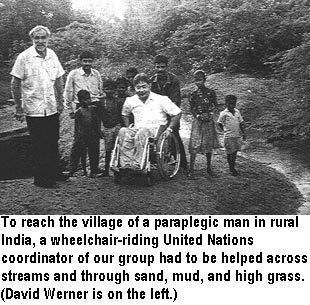
Innovations at the center included a
traditional village, complete with thatched huts and vegetable
gardens. Here, disabled villagers lived and relearned the skills and the
activities of daily living in a typical rural environment.
We saw persons working and moving about there on crutches, or sometimes,
crawling with knee-pads - but few used wheelchairs.
At first, I was concerned by the emphasis on walking rather than on
wheelchair use. In recent years, India's government has launched a major
program of wheelchair production. In cities, at least, increased attention
is placed on wheelchair access (though there continues to be a huge unmet
need).
I asked the Director: "Why such a strong emphasis on walking? Wouldn't
it be more realistic to teach most paraplegic persons to use primarily
wheelchairs?"
"Not at all!" he said. "Most spinal-cord injured persons who pass
through our center come from remote villages, where wheelchair use is
almost impossible.
"You will see for yourselves when we go to a village this afternoon."
He was so right! |
| 232
|
Visit to an Independent Sugar-Cane Farmer Who is Paraplegic
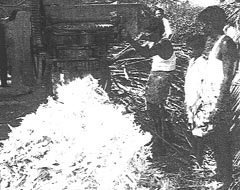
We visited a paraplegic man on the outskirts of a small village. To
reach his homestead, we drove the last 2 or 3 miles over a narrow,
muddy, rutted country road, difficult to travel even in a Jeep. For the
last 200 yards, we had to travel by foot. We quickly realized the
limitations of a wheelchair in such places.
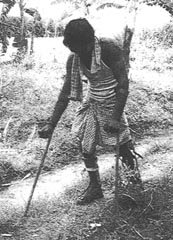
On arrival, we made our way through a muddy field behind a large mud
house. There we saw a man standing next to a small, rustic
gasoline-motor-run sugar-cane mill. He was skillfully pushing armfuls of
green cane into the rolling jaws of the machine. Helping him was a boy
who, we learned, was his son. We had to look twice to realize that the
man was disabled. He wore full-leg braces and arched his body backwards
to stand and work with both hands, without having to support himself
with his crutches.
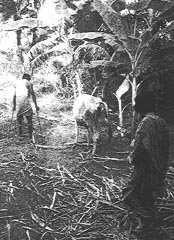
RAM, the man at the mill, saw us approaching. He
bounded over a pile of milled cane and greeted us warmly. He was dark,
muscular, and had a look of uncrushable self-assurance. He appeared to
be in excellent health (better than many people in India's hunger-ridden
rural areas).
We observed Ram doing a variety of daily chores, ranging from
clearing pathways to leading his cow to pasture across the narrow dikes
of a rice field. Totally self-sufficient, he provided for his wife and
children through his own hard physical labor. He had the innovativeness
of one who, since childhood, has lived in a difficult environment where
dexterity and creative ingenuity are essential skills for staving off
hunger and for survival. |
| 233
|
|
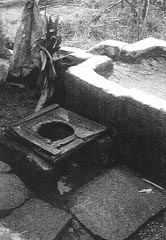
A pit latrine. Ram's innovations included a pit
latrine with a wooden toilet seat (unusual for rural India, where the
custom is simply to squat). He had built it next to a cement-covered
mud-brick water trough. (The pit was over 2 meters deep, in order to
avoid contamination of the surface water that fed the trough, which ran
through a shallow ditch from a spring, 200 yards away.)
Home-grown castor-oil catheter lubricant. Ram had
also found a way to catheterize himself at low cost. Like most
spinal-cord injured persons who lack normal bladder control, to drain
out urine he needed to pass a catheter (clean rubber tube) through his
penis into his bladder every few hours.
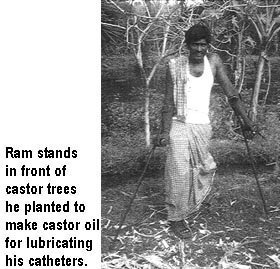 Rubber
catheters can be cleaned and reused hundreds of times (see
Chapter 25, on catheterization). But for
each use, they need to be lubricated (oiled). And commercial medical
lubricants - such as KY Jelly - are expensive. Rubber
catheters can be cleaned and reused hundreds of times (see
Chapter 25, on catheterization). But for
each use, they need to be lubricated (oiled). And commercial medical
lubricants - such as KY Jelly - are expensive.
To save money, Ram had stopped using costly medical lubricants and
had begun to use castor oil. But he soon learned that commercial castor
oil was contaminated, causing repeated urinary infections. So he planted
his own castor trees, harvested the beans, and pressed them carefully
under clean conditions to extract the oil. With this clean home-made
oil, he explained, he now had almost no problems with urinary
infections.
A two-rear-wheel-drive tricycle. For most of his
farm work, Ram moved about with full-leg orthopedic braces and crutches
made at the rehab center in Vellore. But for travel into town, he used
an "all terrain tricycle" that he had designed and built with help from
a local welder.
Most hand-powered tricycles made in India have front-wheel-drive, and
they are therefore useless in mud and sand. The front wheel has little
traction and tends to slip because the person's weight is mostly over
the back wheels.
But Ram's tricycle was different. |
| 234
|

Ram's tricycle has 2 hand cranks (adapted bicycle
pedals), one on either side. With bicycle chains and sprockets, they
power both back wheels.
The steering mechanism consists of a bar extending back from a
bicycle fork that holds the single front wheel. When traveling on a
fairly hard, flat roadway, Ram can steer with one hand and pedal the
chair with the other (one wheel drive). For two-wheel-traction in mud or
sand, he can pedal with both hands. But that means he must let go of the
steering rod.
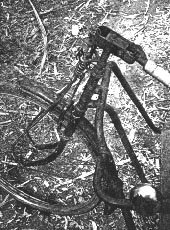
In order to keep the chair moving ahead in a straight line when he is
not holding the steering rod, Ram improvised a spring device on the
steering shaft of the front wheel fork. (See photo on left.)
The 2 springs persistently push the front wheel into a straight
position. When Ram comes to a curve in the path, he lets go of one pedal
just long enough to get around the curve. When he lets go of the
steering rod, the front wheel automatically straightens.
Another advantage of this two-hand rear-wheel-drive tricycle
(compared to one-hand-drive ones) is that for long distances it is less
tiring to use. The rider can provide power with both arms at once, or
use only one arm while resting the other.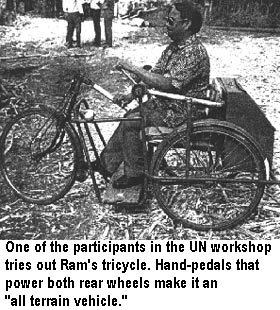
(For more ideas on hand-powered tricycles, see
Chapter 31. For a "4-wheel drive"
all-terrain tricycle, see the drawing at the bottom of
page 343.)
Observing the innovative problem-solving skills of rural disabled
persons like Ram made a deep impression on the visiting rehabilitation
specialists and technicians. By the end of the 10 day workshop, many
declared they would work more as "partners in problem solving" with
disabled clients, and encourage them to design or improve upon their own
devices and solutions.
The visiting professionals gained greater respect for the
creativity and abilities, not only of disabled people, but of poor,
unschooled, disabled people. And that was a big step
forward.
|
|